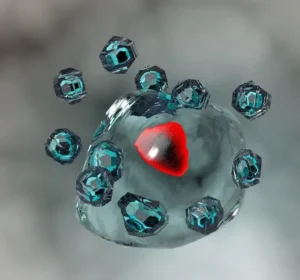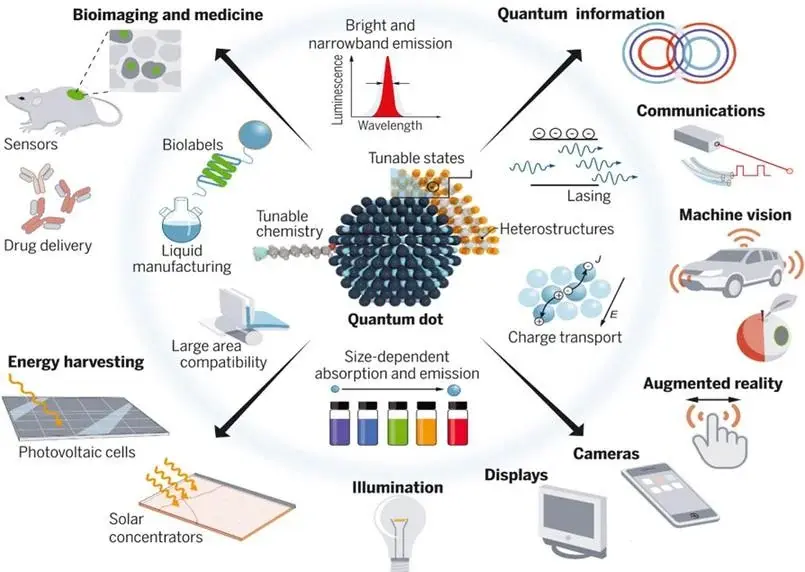QUANTUM DOTS: A NOBEL PRIZE-WORTHY DISCOVERY IN CHEMISTRY
This year, the committee awarded the Nobel Prize in Chemistry 2023 Moungi G. Bawendi, Louis E. Brus, and Alexei I. Yekimov for the discovery and synthesis of quantum dots. The Nobel Committee praised their work. They described it as a “new class of materials”. Molecules are the smallest units of a chemical compound. These materials have many fascinating and unusual properties. They are bringing the greatest benefit to humankind.
Three scientists shared the Nobel Prize. They were recognized for their work in quantum dots. In the early 1980s, Alexei Ekimov made an important breakthrough. He created size-dependent quantum effects in colored glass. He showed that particle size changes the color of glass. This is because of quantum effects, which are changes that occur on a very small scale. Specifically, these changes happen with atoms and particles. Notably, particles can be extremely tiny, sometimes even smaller than atoms.
A few years later, Louis Brus made another significant discovery, building on earlier findings. Specifically, he demonstrated that quantum effects are closely tied to particle size. In other words, when something is size-dependent, it undergoes noticeable changes whenever the size changes. These effects, moreover, occur in particles that float in a fluid. For instance, a fluid can either be a liquid or a gas. Subsequently, in 1993, Moungi Bawendi made a groundbreaking contribution to this field. More specifically, he developed an innovative method that allowed for the creation of quantum dots in precise sizes, which not only possessed exceptionally high optical quality but also opened new avenues for research and applications.
Nanotechnology
In the mid-1980s, scientists introduced the term “quantum dot”. It drew attention from various scientific groups. Nanotechnology is the study and use of very tiny things, like atoms and molecules. Quantum dots are extremely small particles. Their tiny size gives them unique behaviors. Quantum dots are crystals that can conduct electricity. These crystals are very small, at the nanoscale, which is a size range for particles one billionth of a meter. They have special properties related to light and electricity. These are called optical, electronic, and optoelectronic properties.

Quantum confinement effects, in fact, are responsible for these special properties. To be more precise, these effects occur because quantum dots are extremely small. Furthermore, the size and shape of these quantum dots play a crucial role in altering how electrons behave inside them. Consequently, even slight changes in size and shape can significantly impact their electronic properties. Thus, understanding and controlling these factors is essential for optimizing their unique behaviors and applications.
Quantum dots are often made from materials like cadmium selenide (CdSe), cadmium telluride (CdTe), or indium arsenide (InAs). Cadmium selenide is a compound formed by cadmium and selenium.
Cadmium telluride is made of cadmium and tellurium. Indium arsenide is composed of indium and arsenic. The properties of quantum dots depend on their size, shape, composition, structure, surface, and environment. Band gap, luminescence, quantum yield, stability, toxicity, and biocompatibility are fundamental properties of quantum dots. Also, adjusting these allows for specific applications. gaps and high quantum yields. These types are good for giving off light and converting energy efficiently. Others have low toxicity and are highly biocompatible. These are safe for use in bioimaging, which is taking pictures inside the body, and in delivering medicine.
Quantum Dots
Quantum dots’ size-dependent bandgap allows for precise tuning of their light absorption and emission characteristics. This property is very useful for optoelectronic devices. Optoelectronic devices include things like light-emitting diodes (LEDs), solar cells, and photodetectors. Fluorescence properties have greatly transformed biological imaging. After absorbing the light, these materials give it off or release it. This helps scientists see things inside living cells or tissues. Their size-tunable emission spectra, higher brightness, and photo stability make them excellent probes for cellular imaging, drug delivery vehicles, and disease diagnosis. Quantum dots, with their ability to trap and manipulate single electrons, show potential as qubits (quantum bits) in quantum computing architectures. Figure 2 shows the applications of quantum dots in different technologies (adapted from Garcia et al., 2021.

Quantum Dots: Research Area
It represent a new area of research. Researchers, however, encounter several challenges, including stability, efficiency, and safety. These issues, in particular, arise in fields such as biomedicine and environmental engineering applications. Consequently, addressing these challenges becomes essential for the advancement of these areas. Scientists want to integrate quantum dots with other materials in the future. These materials include carbon nanotubes, graphene, nanowires, and nanorods. By combining these materials, scientists aim to create new nanostructures and devices. These new structures will perform better and offer more versatility.
Quantum mechanical properties like entanglement, coherence, and superposition are key research areas. Entanglement is a connection between particles that makes them change together instantly. Coherence, for instance, plays a critical role in helping particles work together smoothly. In addition to this, superposition allows particles to exist in multiple states simultaneously. This means that a particle can, at the same time, exist in different forms and, moreover, occupy different locations. Consequently, researchers are actively and extensively exploring these unique properties to drive the development of innovative technologies. Additionally, these emerging technologies, including quantum computing, cryptography, and advanced information processing, have the potential to revolutionize various fields.
Advancements in Quantum Dots
Quantum computing, for example, utilizes qubits to process data significantly faster than traditional computers. In a similar vein, cryptography plays a vital role in safeguarding data by employing complex codes to ensure its security. Additionally, information processing is dedicated to efficiently managing and organizing data to improve overall functionality. Moreover, alongside these advancements, quantum dots—tiny particles that behave like atoms—exhibit remarkable and unique properties. As a result, scientists are increasingly exploring and applying quantum dots in these innovative fields. Furthermore, they constitute an essential component of technology at an extremely small scale, commonly referred to as nanotechnology. However, despite these promising advancements, it is critically important to establish proper safety assessments, labeling protocols, and disposal guidelines in order to mitigate potential risks and ensure responsible development.

To stay updated with the latest developments in STEM research, visit ENTECT Online. This is our digital magazine for science, technology, engineering and mathematics.







Self-harm leading to death is a complex topic that affects many families across the world.
It is often connected to mental health issues, such as anxiety, hopelessness, or chemical dependency.
People who struggle with suicide may feel isolated and believe there’s no hope left.
https://how-to-kill-yourself.com
It is important to spread knowledge about this topic and offer a helping hand.
Early support can reduce the risk, and talking to someone is a necessary first step.
If you or someone you know is in crisis, get in touch with professionals.
You are not without options, and there’s always hope.
buy armenia virtual phone number online https://virtual-local-numbers.com/countries/1193-armenia-did-number.html for calls, sms, registration (otp)